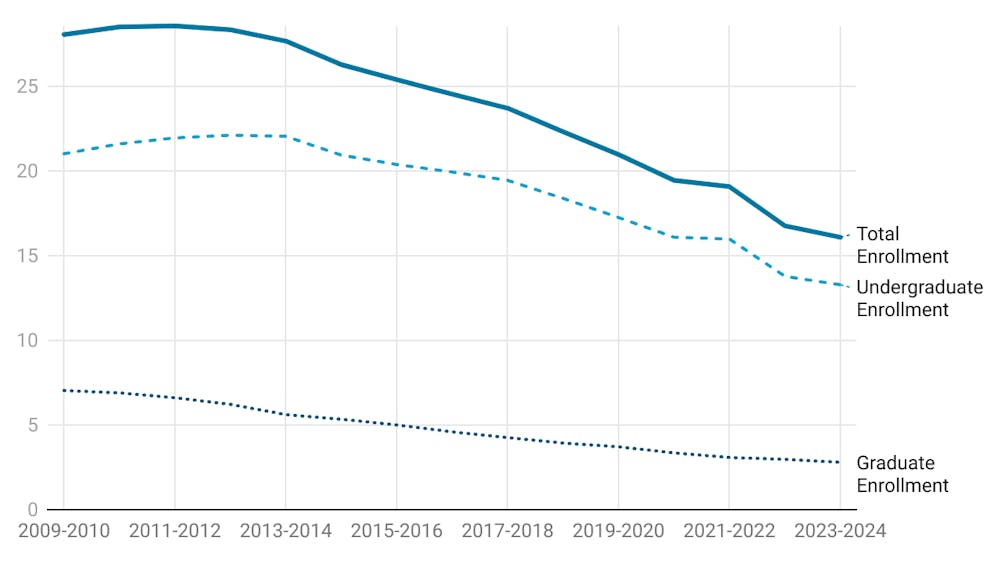Retention rates among FTIAC’s—students who attend school for the first time in any college— have increased while the number of individuals on probation has seen a decrease following several initiatives put into place by
Eastern Michigan University.
“We’ve started to cut into our probation rate, so that same year we increased our retention rate for our FTIACs, the year prior, 2007-08, we had a probation rate of 30 percent. So based on all of the different initiatives we’re doing, we’ve cut that to 19 percent for the end of fall semester,” said Lynette Findley, assistant vice president of retention and student success at EMU.”
Changes being made to EMU policies
Findley said she realized just how important it was to get the probation rates under control after doing research.
“Data will tell you that students that finish their first semester on probation, their likelihood of finishing in four or six years is not strong,” she said. “In fact, only 12 students who were on probation one graduated between 2006 and those years in a four year period and only 59 in six years. That’s how woefully low and that’s how important it is to get off to a great start and make sure you don’t start on probation.”
Findley said starting in 2013, vast changes will be made to EMU’s probation policy.
“I think it’s a travesty that we have a probation one, two and three policy,” she said. “That’s about to change next year and it will be more in line with financial aid and the regulations of financial aid.”
Findley is also suggesting for it to be a requirement for students to take math and English during their first year.
“Students that take math and English, especially math, those students have a stronger six year graduation rate if they take that class their first semester or the first year,” she said. “The retention rate goes up for students that take these courses. For the 2003 cohort, students that graduated six years ago, students that had even taken a remedial class, the six-year graduation rate was 39 percent.”
“Students who did not, their rates were 28 percent. Students that did not have to take the remedial course and just took the gen ed requirement their first or second semester, that graduation rate increased to 56 percent.
It’s about what we’re learning about our student populations. I would like to see it where we require students to take math their first semester. Those are critical classes to help students throughout to increase graduation rates.”
Findley said a number of the initiatives were created under the Student Success Council.
“It was formally known as the Student Retention council which started four years ago,” Findley said. “It was in 2007 that we started and we created a lot of different initiatives to increase the retention and graduation rates of our students. You have these initiatives that we started with the 2009 cohort FTIAC [first year in any college] class.”
Initiatives and programs responsible for increase in rates
One of the things the success council changed was the way the Promote Academic Survival and Success program operated. Before changes were made, it was known as a “voluntary program” and students were allowed to take courses as they pleased.
“What I thought back then in 2008 was we were letting students come in without any academic provisions to make sure they were taking care of the things they needed to so we overhauled it,” she said.
One of the changes made was that students were now required to sign a contract with outlined stipulations.
“In that contract we stated that they should not take more than 12 credit hours and they could not get involved with any type of sororities, fraternities or social groups and they had to meet with the Holman Success G.A. every other week for academic support and workshops,” Findley said. “They must do that and if they didn’t they weren’t allowed to register for the next semester.”
Findley said the results were “amazing.”
“By doing this you’d be amazed to that’s how we were able to increase in one year by looking at the population and making sure we were giving them mandatory type services,” she said. In 2009, we had the first year retention rate for that cohort and it was 76 percent compared to 70 percent in the past and they were the highest group of any rates that year which is phenomenal in higher education.”
Findley said others within the higher education community began to take notice after seeing retention rates increase.
“We had people saying, ‘well, how’d you do that?’” she said. “You have to look at that population there and continue to plan on from there, for which we did for the next year. We had a five percent increase. The goal is to do better. We are maintaining that and you have to look at those cohorts over the next six years. You won’t see a change in the graduation rates until then.”
Findley said the university has also modified the way academic advising works.
“What we tried to do with academic advising is that once a student declares a major, they’re supposed to go directly to that college for advising and we thought that was so unfair to students,” she said. “Generally faculty members would agree that they would prefer to advise students after they have gotten gen eds out of the way. That’s what faculty members should be doing is that major advising overall. What we decided to do was we changed the way we did advising. All of the advisors are assigned by college in the Academic Advising Center now.”
Findley said advisors now have more of a hands-on approach with students since they now send out welcome notes to new students and various types of communications.
“I didn’t want any student to feel as if they hadn’t been touched by an academic advisor,” she said. “Freshman students who started with that same cohort could not tell you, unless they chose not to read the emails, that they had not had contact with an academic advisor. What I wanted the staff in academic advising to do was to help them and give them any information they needed.”
Findley reiterated the fact that the nation as a whole needs to learn how to educated at risk populations but that EMU is on the path to figuring out how to do so.
“We should happy that we have basically learned how to start doing this,” she said. “You’d be surprised how many universities aren’t doing this or don’t know how to do this. We could be a national model for this. We’re headed in the right direction and you’ll see the numbers.”
The university community responds
History professor Mark Higbee believes EMU’s students deserve more from the university and that more initiatives need to be created and implemented in addition to what is already done.
“I’ve studied the issue and the interventions that are done at other schools could be done here and that’s a complicated thing,” he said. “We should create a first year program for entering students that says take this because it will build your skills for college success and do that and implement that.”
“We put most first year students in big lecture classes and the get lost and they get bored and they drop out… Our general education program produces dropouts. That doesn’t mean that I’m saying that any of the gen ed courses are bad courses. They just often are not appropriate for where are students are. I think our graduation rates are terrible compared to what we should be achieving and it’s terrible compared to what our students deserve,” he said. “We could do a lot better.”
Higbee said the university should also raise the admission standards.
“EMU admits all kinds of students,” Higbee said. “Some of our very best students would do very well if they could go and afford to pay tuition at Harvard. Then we have students here that are admitted that are illiterate. They can’t read a page. That first group that could go to Harvard do very well at Eastern. The second group, they can’t get through their classes and they should not be able to get through their classes without being literate.”
“I think we should raise admission standards. We admit students who are not succeeding in college I don’t know how many that is but I see them every year. Then we admit students who are at risk that could do well in college and we should give them that support. I think those are two different groups and instead of distinguishing between the two of them the university treats them as one group.”
Higbee said there is “broad agreement” among faculty members that EMU has an admissions problem.
“We admit students that are unprepared for college and that we have no plans to get them up to speed and I think most of my faculty colleagues regard it as immoral,” he said. “I don’t think that explains all of our attrition problems though. Our potential at EMU to increase our graduation rate is immense and unlimited but we can’t do it by just doing the same old things we’ve been doing. It needs to be systemic and address all first year students. Students who are academically promising and students who are at risk, we lose both types of students and we ought to address that but we don’t.”
EMU student Lesly Dencamp believes the university is doing all it can to increase the rates.
“What more can they do?” Dencamp said. “I’m proud to say I go to Eastern and I think most of us are because it’s definitely a school of opportunity.”









